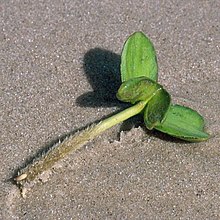You are here
Magnoliopsida
Avicennia L.
EOL Text
Avicennia is a genus of flowering plants currently placed in the bear's breeches family, Acanthaceae. It contains mangrove trees, which occur in the intertidal zones of estuarine areas and are characterized by aerial roots. It is commonly known as api api which in the Malay language means "fires", a reference to the fact that fireflies often congregate on these trees.[2] Species of Avicennia occur worldwide south of the Tropic of Cancer.
The taxonomic placement of Avicennia is contentious. In some classifications it has been placed in the family Verbenaceae, but more recently has been placed by some botanists in the monogeneric family Avicenniaceae. Recent phylogenetic studies have suggested that Avicennia is derived from within Acanthaceae, and the genus is included in that family in the Angiosperm Phylogeny Group system.
Designation of species is made difficult by the great variations in form of Avicennia marina. Between eight and ten species are usually recognised, with Avicennia marina further divided into a number of subspecies.
The generic name honours Persian physician Avicenna (980-1037).[3]
Contents
Description[edit]
Members of the genus are among the most salt tolerant mangroves and are often the first to colonise new deposits of sediment. The sap is salty and excess salt is secreted through the leaves. The spreading root system provides stability in shifting substrates. There are vertical roots called pneumatophores projecting from the mud. These are used in gas exchange as there is very little oxygen available in the mud. The flowers are fragrant and rich in nectar and are pollinated by insects. The embryos exhibit cryptovivipary, a process where they start to develop before the seed is shed but do not break through the outside of the fruit capsule.[4]
Selected species[edit]
- Avicennia africana P.Beauv.
- Avicennia alba Blume
- Avicennia bicolor Standl.
- Avicennia eucalyptifolia (Valeton) Moldenke
- Avicennia germinans (L.) L. — Black Mangrove
- Avicennia integra N.C.Duke
- Avicennia marina (Forssk.) Vierh. — White or Grey Mangrove
- Avicennia nitida Jacq.
- Avicennia officinalis L.
- Avicennia rumphiana Hallier f.
- Avicennia schaueriana[5]
See also[edit]
References[edit]
| Wikimedia Commons has media related to Avicennia. |
| Wikispecies has information related to: Avicennia |
- ^ a b "Genus: Avicennia L.". Germplasm Resources Information Network. United States Department of Agriculture. 2006-03-30. Retrieved 2010-05-26.
- ^ Api-api Putih (Avicennia alba) The Tide Chaser. Retrieved 2012-02-08.
- ^ Quattrocchi, Umberto (2000). CRC World Dictionary of Plant Names. 1 A-C. CRC Press. p. 242. ISBN 978-0-8493-2675-2.
- ^ Api Api Mangrove and wetland wildlife at Sungei Buloh Nature Park. Retrieved 2012-02-08,
- ^ "GRIN Species Records of Avicennia". Germplasm Resources Information Network. United States Department of Agriculture. Retrieved 2010-05-26.
Further reading[edit]
- Boland, D. J. (1984). Forest Trees of Australia (Fourth edition revised and enlarged). CSIRO Publishing, Collingwood, Victoria, Australia. ISBN 0-643-05423-5. .
- Duke, N.C. (1991). "A Systematic Revision of the Mangrove Genus Avicennia (Avicenniaceae) in Australasia". Australian Systematic Botany 4 (2): 299–324. doi:10.1071/SB9910299.
- Schwarzbach, Andrea E. and McDade, Lucinda A. 2002. Phylogenetic Relationships of the Mangrove Family Avicenniaceae Based on Chloroplast and Nuclear Ribosomal DNA Sequences. Systematic Botany 27: 84-98 (abstract here).
| License | http://creativecommons.org/licenses/by-sa/3.0/ |
| Rights holder/Author | Wikipedia |
| Source | http://en.wikipedia.org/w/index.php?title=Avicennia&oldid=587523060 |
Description as for the family.
| License | http://creativecommons.org/licenses/by-nc/3.0/ |
| Rights holder/Author | Mark Hyde, Bart Wursten, Petra Ballings, Flora of Zimbabwe |
| Source | http://www.mozambiqueflora.com/speciesdata/genus.php?genus_id=2204 |
Depth range based on 7 specimens in 6 taxa.
Environmental ranges
Depth range (m): 0 - 1
Graphical representation
Depth range (m): 0 - 1
Note: this information has not been validated. Check this *note*. Your feedback is most welcome.
| License | http://creativecommons.org/publicdomain/mark/1.0/ |
| Rights holder/Author | Ocean Biogeographic Information System |
| Source | http://www.iobis.org/mapper/?taxon_id=739379 |
Pressure makes air move: black mangrove
Underwater roots of mangroves move air via changes in gas pressure.
"Simple physical diffusion through the lenticels and along the aerenchyma is probably the main mode of gas movement in mangrove roots, but it may be supplemented by mass flow […] There is a more convincing interpretation of the observed pressure changes which provide a mechanism for the mass flow of air into a root to supplement diffusion. Lenticels are hydrophobic, so that while a root is covered by water they are in effect closed: neither air nor water can enter. Respiration removes oxygen from the air spaces and produces carbon dioxide. Because it is highly soluble in water, the carbon dioxide does not replace the volume of oxygen removed, and gas pressure within the root is therefore reduced. This is confirmed by direct measurement of gas composition in a submerged Avicennia root. After a root is covered by the tide, oxygen within it falls, carbon dioxide levels do not increase to compensate, and pressure falls. When the tide recedes and the lenticels are again open, air is sucked in (Scholander et al. 1955)." (Hogarth 1999:9-10)
Learn more about this functional adaptation.
- Hogarth, P. J. The biology of mangroves. Oxford University Press. 228 p.
| License | http://creativecommons.org/licenses/by-nc/3.0/ |
| Rights holder/Author | (c) 2008-2009 The Biomimicry Institute |
| Source | http://www.asknature.org/strategy/71b881e33cd1f15ba7968a689bda25c6 |
Barcode of Life Data Systems (BOLD) Stats
Specimen Records:108
Specimens with Sequences:131
Specimens with Barcodes:124
Species:7
Species With Barcodes:6
Public Records:98
Public Species:6
Public BINs:0

